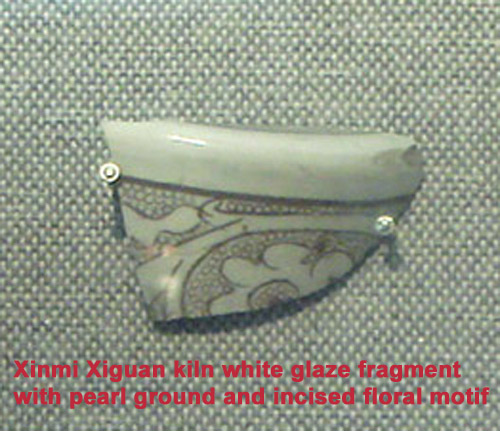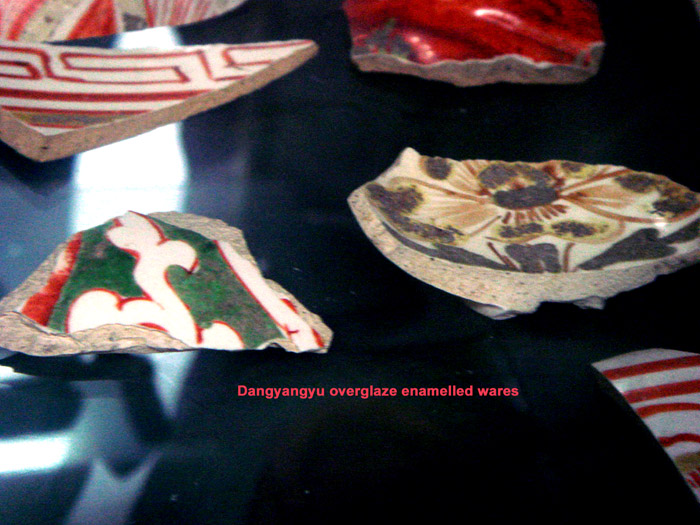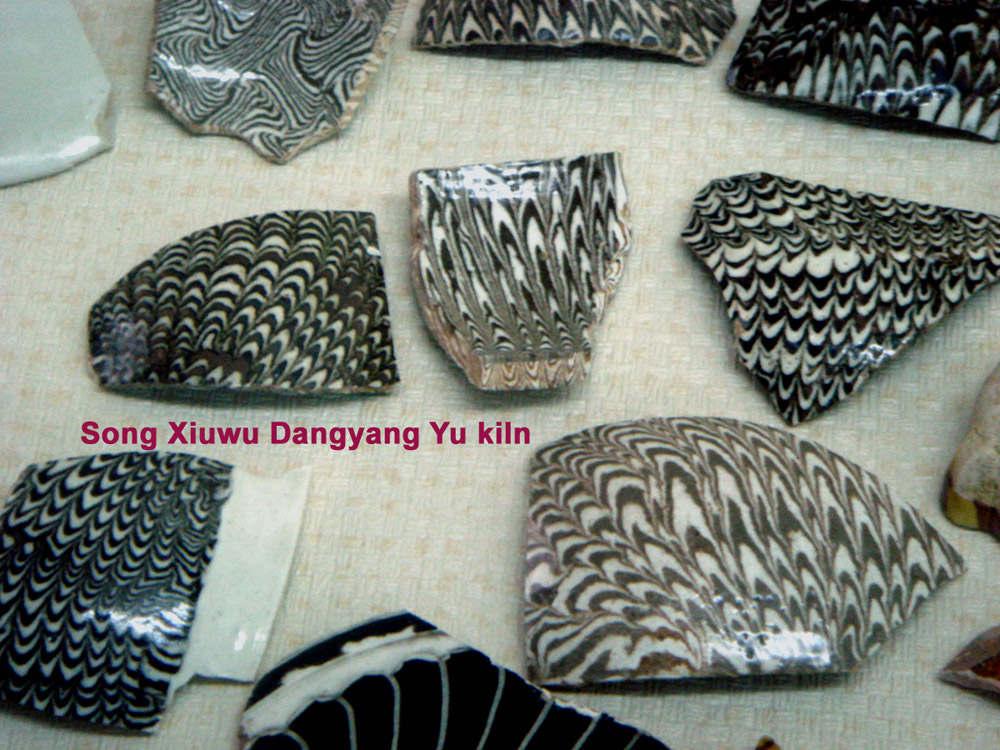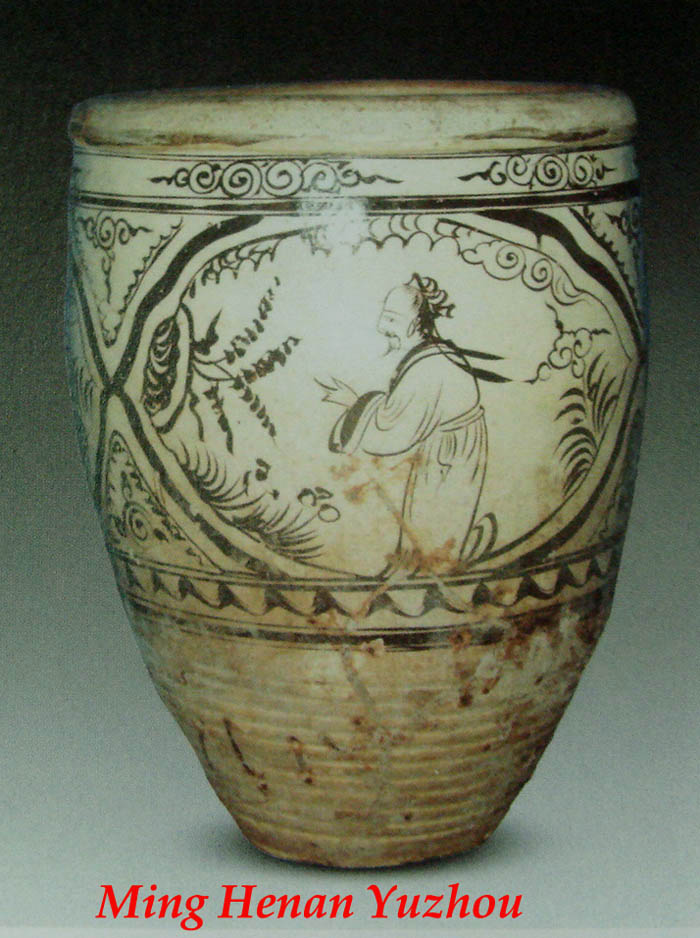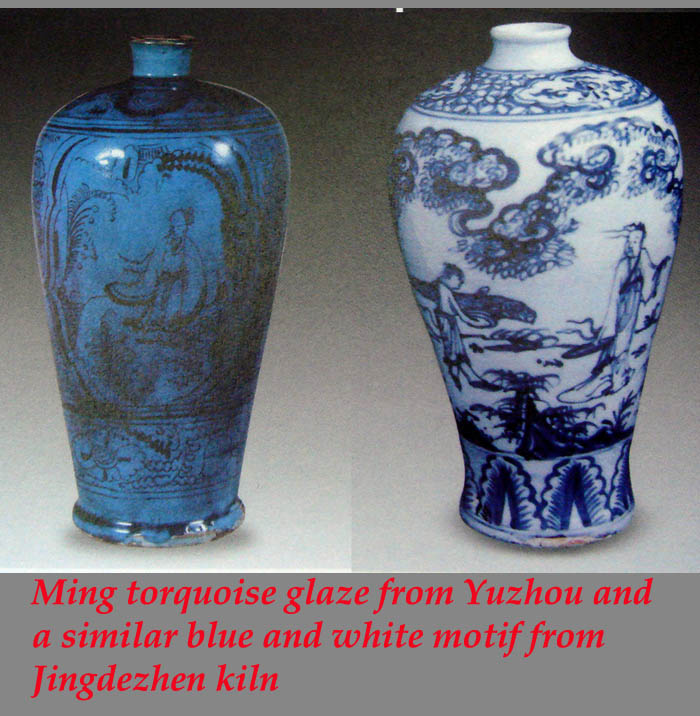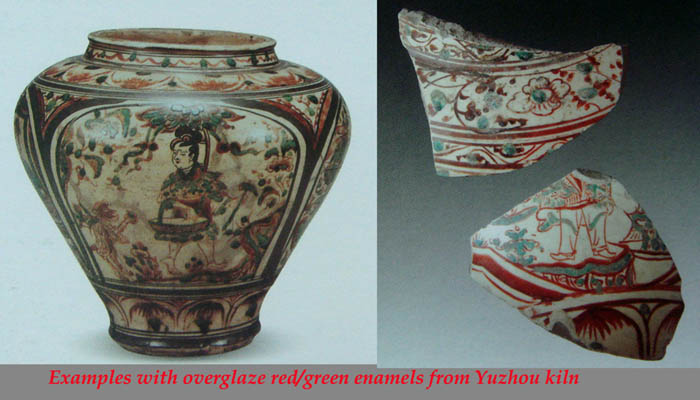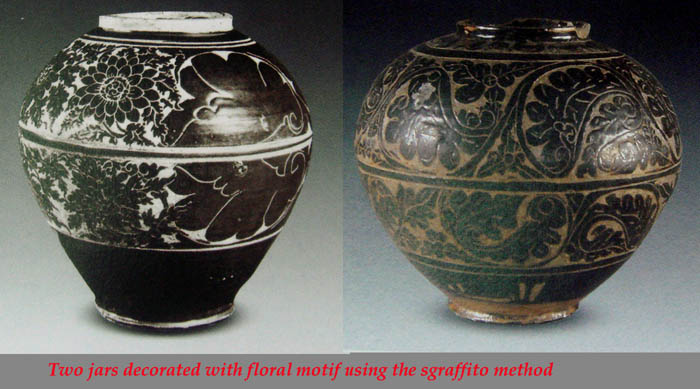Cizhou Wares
Cizhou wares are a distinctive group of common folk vessels introduced during Northern Song period. It gained immense popularity during the Song/Yuan period and still continued to be produced till today. The typical cizhou wares consisted of a milky white glaze with iron black/brown painted motif and those carved black motif on white/gray slip ground or milky white motif on slip black or grayish paste ground. The milky white glaze is the result of application of white slip over a gray body of the ware which is then covered by a layer of transparent glaze. There are other decorative types such as those painted with polychrome motif, torquoise or green glaze wares. It is indeed amazing how the potters had overcome the inferiority of the raw materials and came out with so many imaginative decorative techniques to produce so many aesthetically beautiful artworks.
Archaeological studies have revealed that the two major centers of production are Guantai [located in Hebei Ci County, ceased production after early Ming] and the other at Pengcheng continued production till Qing Dynasty.
There are numerous other kilns located in Hebei Province, Henan Province [some famous ones such as Xiuwu Dangyangyu, Tangyin Hebiji, Yuzhou Pacun, Dengfeng], Shanxi Province [Yaozhou], Ningxia Province [Lingwu],Inner Mongolia [chifeng], Shanxi [Jiexiu, Pingding], Shandong, Anhui, Jiangxi [Jizhou] and Guandong which produced similar wares. There are definitely some local stylistic decorative differences and also in terms of shape/form and glaze and paste appearance. Yet one can still discern that they are unmistakably cizhou in character especially in terms of the decorative techniques. Hence, they are widely termed as cizhou type wares.
Cizhou Wares’ Decorative techniques
Carved/incised/scrapped motif
The earliest Cizhou type carved/incised motif could be traced to the stamped pearls-like ground and incised motif produced by Xinmi Xiguan kiln during the late Tang period. Such wares gained much popularity during the Northern Song period and were produced in a number of kilns, the most famous being Dengfeng Quhe kiln.
During the Northern Song period, carved/incised motifs was the most popular Cizhou ware. In its simplest form, a gray outline of the motif is created by incising on the white slip to reveal the gray body.
Alternatively, to create the visual effect of embossed motif. The white slip area which constitutes the background is scrapped away to reveal the gray body. This method is commonly called sgraffito.
A technically more sophisticated method involves vessel covered with two layer of slips: a black iron oxide black slip over the white slip. A striking and contrasting effect is created by scraping away the top layer slip which is outside the outline of the motif. Those sgrafitto wares from Xiuwu Dangyangyu represented the highest standard of such wares.
By the Jin period, wares using the incised/carved/ combined with combing method became popular. Such wares were found in kilns in area such as Guangtai, Hebi, Xinan, Defeng and etc.
Iron black/brown Painted Motif
Another outstanding contribution of the Cizhou potters was painting of traditional Chinese art painting on the wares. During the late Northern Song period, white glaze with painted iron black/brown motif emerged. It became one of the dominant product during the Jin and Yuan period. Besides Guantai and Pengcheng, in Henan, the best products in this category could be found in Yuzhou Pacun kiln. It is typified by white glaze and glossy black motif. Pacun kiln also produced many large basin with flat rim. Most from other kilns tend to have a slightly yellowish glaze. Some of the iron-painted motif were also covered with torquoise or green glaze. Iron-painted wares were produced in numerous kilns in Henan such as those in Xinmi, Jiaxian, Yuzhou, Lushan, Yiyang, Hebi and etc.
During the Yuan Dynasty, the painted wares usually used a combination of iron-black and brown. There were also type which the iron-painted motif was further incised with finer details. Pillows of the period became more elongated with a length of more than 40 cm. Many of the bowls were simply decorated with characters at the inner bottom.
According to Nigel Wood in his book Chinese glazes, the Cizhou glaze is unusually low in calcium oxide and high in alumina. Hence, it is viscous and greatly controlled the diffusion of the underglaze iron pigments and the motif thus retained its sharpness.
To create a even greater pictorial effect, on some vessels, some of the details of the painted motif is incised, such as the vein of the leaves or petals.
The range of motifs is wide, including fishes, flowers, birds, animals , human subjects, legends and poems. The spontaneous, unrestrained and vigorous strokes coupled with good composition of the motifs resulted in truly artistically charming and appealing folk art.
Overglaze Polychrome painted and other Cizhou wares
During the Jin period, wares decorated with overglazed green, yellow and red were introduced. The more notable kilns producing such wares are Xiuwu Dangyangyu and Yuzhou Pacun. In Pacun, black enamel were also used for some parts of the motif. This method requires two firing. Firstly, the glazed ware is fired at high temperature. The over-glazed decoration is then painted using red, green and yellow enamels and subsequently fired at a lower temperature.
Cizhou also produced black glaze, black glazed cum iron-rust wares and also Ding type white glaze molded motifs. There were also low-fired green and yellow lead-glazed sancai wares .
The marbled wares which first appeared during the Tang dynasty continued to be produced. The kiln which is usually associated with such wares is Xiuwu Dangyangyu .
Ming Cizhou wares
In the past, there were little information available regarding Ming Cizhou wares. In fact, it is not surprising to find Ming Cizhou dated wrongly as Song/Yuan Period. For those interested in this subject, the book Ming Dai Cizhou Yao ciqi by Guo Xuelei provides a very instructive introduction on the subject.
Cizhou wares from Northern China continued to be popular but was mainly produced for domestic consumption. However, a small number found their way to foreign lands. Some of them could be seen in the Indonesia Jakarta museum.
The main production centres were in Hebei Handan Pengcheng, Henan Yuzhou and Shanxi province. Penchengr continued production even during Qing Dynasty. According to official Ming records ‘ Ming Huidian’, during the Ming dynasty Pengcheng had about 40 official 40 kilns producing jars for the imperial Guanglu temple. During 11th year of Hongzhi, they produced more than 10,000 pieces of jars/vases for palace daily use.
The most common decorative technique is underglaze iron black and/or iron brown motif. On pots, jars and vases, the main motifs are usually depicted within several windows separated by floral scrolls or cloud-like spirals The motifs are executed using calligraphic like strokes. Visually they appear spontaneous, lively and vigorous.
Henan Yuzhou also produced those with iron black motif with a torquoise glaze. Some of the motifs used by the Cizhou potters were similar to those produced in Jingdezhen. For example, compare motif in the below meipings.
Those vessels decorated with overglaze green/red enamelled motif also continued to be produced..
Shanxi kilns continued to produce many jars decorated using the sgraffito method. The motif is first incised on the glazed body, followed by the area outside the motif being scrapped away. This creates an embossed motif effect.
